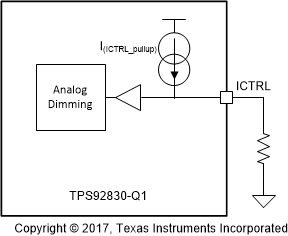JAJSE12A October 2017 – October 2017 TPS92830-Q1
PRODUCTION DATA.
- 1 特長
- 2 アプリケーション
- 3 概要
- 4 改訂履歴
- 5 概要(続き)
- 6 Pin Configuration and Functions
- 7 Specifications
- 8 Detailed Description
- 9 Application and Implementation
- 10Layout
- 11デバイスおよびドキュメントのサポート
- 12メカニカル、パッケージ、および注文情報
8.3.5.2 Internal High-Precision Pullup Current Source
An internal precision pullup current I(ICTRL_pullup) is provided within the device to minimize external component count. I(ICTRL_pullup) uses current reference I(IREF) as reference. With the internal pullup current source, only an external resistor between the ICTRL pin and GND is needed to set the ICTRL voltage and the analog dimming ratio.
If a voltage source or resistor divider is used, the internal pullup current must be taken into account to set the analog dimming ratio accurately.
The pullup current source pulls the ICTRL pin voltage up to input voltage V(IN) if the ICTRL pin is unconnected. When ICTRL is not used, it is recommended to leave the ICTRL pin floating.
 Figure 27. Internal High-Precision Pullup Current Source
Figure 27. Internal High-Precision Pullup Current Source